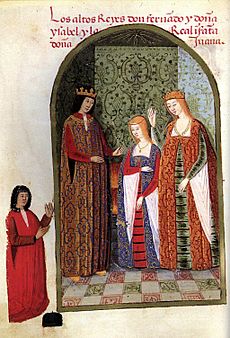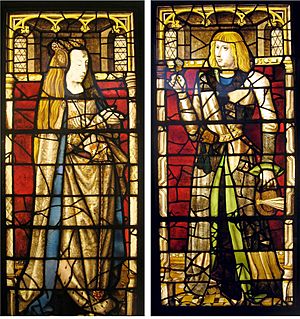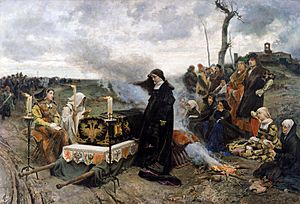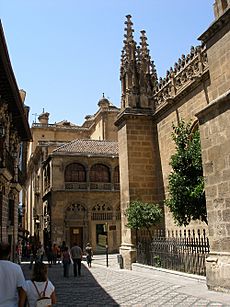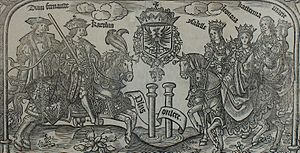Joanna of Castile facts for kids
Quick facts for kids Joanna of Castile |
|
|---|---|
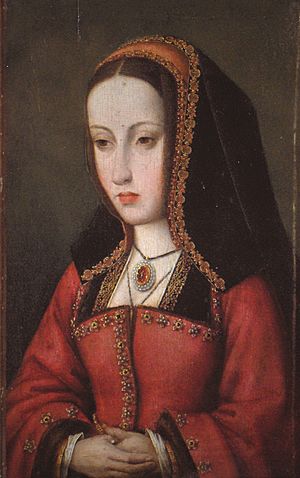
Portrait by the Master of Affligem, around 1500
|
|
| Queen of Castile and León | |
| Reign | 26 November 1504 – 12 April 1555 |
| Predecessors | Isabella I and Ferdinand V |
| Successor | Charles I |
| Co-monarchs | Philip I (1506) Charles I (1516–1555) |
| Regents |
See
|
| Queen of Aragon, Navarre, Sicily, Naples, Sardinia, and Countess of Barcelona | |
| Reign | 23 January 1516 – 12 April 1555 |
| Predecessor | Ferdinand II |
| Successor | Charles I |
| Co-monarch | Charles I |
| Born | 6 November 1479 Toledo, Castile |
| Died | 12 April 1555 (aged 75) Tordesillas, Castile |
| Burial | Royal Chapel of Granada, Granada, Castile |
| Spouse | |
| Issue |
|
| House | Trastámara |
| Father | Ferdinand II of Aragon |
| Mother | Isabella I of Castile |
| Religion | Catholic Church |
| Signature | |
Joanna of Castile (6 November 1479 – 12 April 1555), often known by the nickname Joanna the Mad (in Spanish, Juana la Loca), was the Queen of Castile starting in 1504, and the Queen of Aragon starting in 1516. She was the daughter of the famous "Catholic Monarchs," Queen Isabella I of Castile and King Ferdinand II of Aragon.
Through a series of unexpected family tragedies, Joanna became the heir to the Spanish kingdoms. She married an Austrian archduke, Philip the Handsome, in 1496. After her mother's death, Joanna became Queen of Castile. However, she had very little real power during her long reign.
Her father and later her son declared that she was mentally unwell and unable to rule. They locked her away in a palace in Tordesillas for most of her life. Her husband Philip ruled briefly as king, and after his death, her father and then her son Charles ruled in her name. Even though she was the rightful queen, she remained a prisoner until she died at the age of 75.
Contents
Early Life and Education
Joanna was born in the city of Toledo, Spain. She was the third child of Queen Isabella I and King Ferdinand II. She had fair skin, brown eyes, and reddish-blonde hair, much like her mother and her younger sister, Catherine of Aragon, who would later become the first wife of King Henry VIII of England.
A Royal Education
As a princess, or infanta, Joanna received an excellent education. She was not expected to become queen, but she was trained to make a powerful marriage alliance. This would help protect her family's kingdom and build peaceful relationships with other countries.
Her education included:
- Languages: She learned Castilian (an early form of Spanish), Catalan, French, and Latin.
- Academic Subjects: She studied law, history, mathematics, and philosophy.
- Royal Skills: She learned court etiquette, dancing, drawing, and how to ride horses.
- Arts and Music: Joanna was talented in music and could play the clavichord, guitar, and monochord.
Her main teachers were a priest named Andrés de Miranda and a respected scholar named Beatriz Galindo. Her own mother, Queen Isabella, also played a big part in her education.
Marriage to Philip the Handsome
In 1496, when Joanna was 16, she was engaged to Philip of Austria, who was 18. He was called "Philip the Handsome" because of his good looks. His father was Maximilian I, the Holy Roman Emperor. This marriage was a political plan to unite their powerful families against France.
Joanna sailed from Spain to the Low Countries (modern-day Belgium and the Netherlands) for the wedding. The formal marriage took place on 20 October 1496. Together, Joanna and Philip had six children. All of them grew up to become emperors or queens, making them one of the most powerful families in Europe.
Becoming the Heir to the Throne
Joanna was never supposed to rule Spain. She had an older brother, John, and an older sister, Isabella. But a series of sad events changed everything. Her brother John died, then her sister Isabella died, and finally, Isabella's young son Miguel also died.
Suddenly, Joanna was the next in line for the thrones of both Castile and Aragon. In 1502, the Spanish courts officially recognized her as the heir, giving her the title Princess of Asturias.
A few years later, Joanna and Philip traveled back to Spain. While there, Joanna gave birth to their fourth child, Ferdinand, who would later become a Holy Roman Emperor.
A Queen Without Power
The Struggle for Castile
When Joanna's mother, Queen Isabella, died in 1504, Joanna became the official Queen of Castile. However, a power struggle began immediately. Her father, Ferdinand, and her husband, Philip, both wanted to control the kingdom.
Her father claimed that Joanna's "illness" made her unable to rule. He had coins made with both his and Joanna's names on them, and he convinced the court to let him govern. Meanwhile, Philip also wanted to be king and started making his own coins.
Joanna was caught in the middle. In 1506, she and Philip traveled to Castile to claim their throne. The Spanish nobles supported them, and her father Ferdinand had to step aside. Ferdinand and Philip secretly signed a treaty agreeing that Joanna was "incapable of ruling" and should be excluded from the government. However, Ferdinand quickly went back on this part of the deal, saying his daughter should never lose her rights as queen.
The Death of Her Husband
Philip's time as king was very short. Just a few months after arriving in Spain, he died suddenly in September 1506 from an illness, likely typhoid fever. At the time, Joanna was pregnant with their sixth child, Catherine.
Joanna was overcome with grief. She refused to be separated from her husband's body and traveled with his coffin for months. This unusual behavior fueled the rumors that she was mentally unstable. The country fell into chaos, with no strong leader to guide it.
Confined by Her Father and Son
Seeing the disorder, Joanna's father, Ferdinand, returned to Castile in 1507. He forced Joanna to give him control of the kingdom. In 1509, he had her confined to the Royal Palace in Tordesillas, a small town in Spain. He dismissed all her loyal servants and left her with only a few people who answered to him.
For the rest of her life, Joanna was a queen in name only. All official documents were issued in her name, but it was her father who signed them and made all the decisions.
When Ferdinand died in 1516, Joanna also inherited his kingdom of Aragon. But her situation did not change. Her 17-year-old son, Charles, arrived in Spain. He met with his mother and got her permission to rule as her co-king. But like his grandfather, Charles kept Joanna locked away in Tordesillas. She remained a prisoner for the next 39 years while her son became one of the most powerful rulers in the world, known as Emperor Charles V.
The Revolt of the Comuneros
In 1520, a rebellion known as the Revolt of the Comuneros broke out in Castile. The rebels were unhappy with the influence of Charles's foreign advisors. They wanted Castile to be governed by Castilians.
The rebels went to Tordesillas and asked Queen Joanna for her support. If she had signed a document supporting them, their rebellion would have become legal, and they might have won. It was a huge decision. Although she felt sympathy for their cause, her advisors convinced her that supporting the revolt would damage the kingdom and her son's rule. She refused to sign, and the rebellion was eventually defeated. Her choice helped secure the throne for her son, Charles.
Was She Really "Mad"?
As a young woman, Joanna was known to be very intelligent and talented. The stories about her being "mad" only started after she was married. Today, historians are not sure what to believe.
- Some historians think she may have suffered from a real mental illness, such as severe depression (sometimes called melancholia) or psychosis.
- Other historians argue that her father and husband exaggerated or even invented her illness. By declaring her unfit to rule, they could take power for themselves.
It is possible that the grief from her husband's death, combined with the pressure from her family, was too much for her to handle. But it is also true that the men in her life gained a great deal by keeping her locked away. The truth about her mental health remains one of history's great mysteries.
Death and Burial
Joanna's health grew worse in her final years. She died on 12 April 1555, at the age of 75, in the palace at Tordesillas where she had been held for nearly 50 years.
She is buried in the Royal Chapel of Granada alongside her famous parents, Isabella and Ferdinand, and her husband, Philip.
Children
Joanna and Philip had six children, all of whom became important European rulers.
| Name | Birth | Death | Notes |
|---|---|---|---|
| Eleanor | 15 November 1498 | 25 February 1558 | Became Queen of Portugal and later Queen of France. |
| Charles | 24 February 1500 | 21 September 1558 | Became King of Spain and Holy Roman Emperor. |
| Isabella | 18 July 1501 | 19 January 1526 | Became Queen of Denmark. |
| Ferdinand | 10 March 1503 | 25 July 1564 | Became Holy Roman Emperor after his brother Charles. |
| Mary | 18 September 1505 | 18 October 1558 | Became Queen of Hungary and Governor of the Netherlands. |
| Catherine | 14 January 1507 | 12 February 1578 | Became Queen of Portugal. |
Ancestry
| Ancestors of Joanna of Castile | |||||||||||||||||||||||||||||||||||||||||||||||||||||||||||||||||||||||||||||||||||||||||||||||||||||||||||||||||||||||||||||||||||||||||||||||||||||||||||||||||||||||||||||||||||||||||||||||||||||||||||||||||||||||||||||||||||||||||||||||||||||||||||||||||||||||||||||||||||||||||
|---|---|---|---|---|---|---|---|---|---|---|---|---|---|---|---|---|---|---|---|---|---|---|---|---|---|---|---|---|---|---|---|---|---|---|---|---|---|---|---|---|---|---|---|---|---|---|---|---|---|---|---|---|---|---|---|---|---|---|---|---|---|---|---|---|---|---|---|---|---|---|---|---|---|---|---|---|---|---|---|---|---|---|---|---|---|---|---|---|---|---|---|---|---|---|---|---|---|---|---|---|---|---|---|---|---|---|---|---|---|---|---|---|---|---|---|---|---|---|---|---|---|---|---|---|---|---|---|---|---|---|---|---|---|---|---|---|---|---|---|---|---|---|---|---|---|---|---|---|---|---|---|---|---|---|---|---|---|---|---|---|---|---|---|---|---|---|---|---|---|---|---|---|---|---|---|---|---|---|---|---|---|---|---|---|---|---|---|---|---|---|---|---|---|---|---|---|---|---|---|---|---|---|---|---|---|---|---|---|---|---|---|---|---|---|---|---|---|---|---|---|---|---|---|---|---|---|---|---|---|---|---|---|---|---|---|---|---|---|---|---|---|---|---|---|---|---|---|---|---|---|---|---|---|---|---|---|---|---|---|---|---|---|---|---|---|---|---|---|---|---|---|---|---|---|---|---|---|---|---|---|---|
|
|||||||||||||||||||||||||||||||||||||||||||||||||||||||||||||||||||||||||||||||||||||||||||||||||||||||||||||||||||||||||||||||||||||||||||||||||||||||||||||||||||||||||||||||||||||||||||||||||||||||||||||||||||||||||||||||||||||||||||||||||||||||||||||||||||||||||||||||||||||||||
See also
 In Spanish: Juana I de Castilla para niños
In Spanish: Juana I de Castilla para niños


